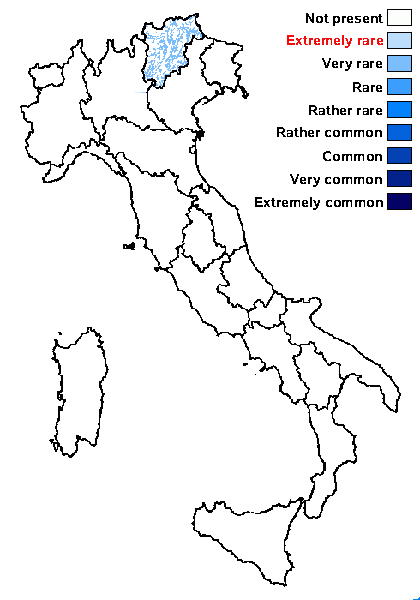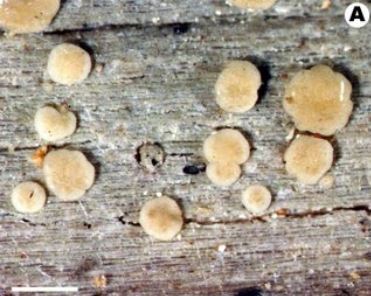Puttea exsequens (Nyl) Printzen & Davydov
in Davydov & Printzen, Bryologist, 115, 1: 68, 2012. Basionym: Lecidea exsequens Nyl. - Flora, 64: 179, 539, 1881
Synonyms: Lecidea gibberosa sensu Th. Fr. non Ach.
Distribution: N - TAA (Nascimbene & al. 2022).
Description: Thallus crustose, very thin, whitish or endosubstratic, inconspicuous. Apothecia biatorine, rounded to slightly irregular in outline, sessile with a weakly constricted base, 0.3-0.7 mm across, with a flat to slightly convex, ochre or orange- to red-brown, matt disc appearing pruinose when wet, and an inapparent to very thin, mostly concolorous or slightly paler proper margin. Proper exciple colourless in outer part, covered in a continuous layer of crystals soluble in K, the hyphae 0.5-1.2 μm thick, richly branched, closely septate with narrow, 0.5-1 μm wide lumina, running parallel and perpendicularly from the medullary exciple of gelatinized textura intricata; epithecium scarcely differentiated from the hymenium, pale yellowish brown, with a layer of hyaline crystals soluble in K and N, 5-10 μm high; hymenium colourless, 45-55 μm high; paraphyses weakly to moderately branched and anastomosing, with 0.8-1 μm thick, with thin lumina, the apical cells up to 1.2 μm wide; hypothecium colourless, 25-175 μm high. Asci 8-spored, clavate, with a K/I+ blue tholus including a thin, darker K/I+ blue tubular ring-structure. Ascospores 1-celled, hyaline, fusiform-ellipsoid, 8-11 x 3-4.5 μm. Photobiont chlorococcoid. Spot tests: thallus K-, C-, KC-, C-, P-, UV-. Chemistry: probably without lichen substances.Note: typically on wood, widespread in Eurasia, but rarely collected, with a single recent record from the Eastern Alps of Slovenia, but likely to be still overlooked elsewhere (perhaps misidentified as a Biatora-species). For further details see Davydov & Printzen (2012). To be looked for further in the Italian Alps.
Growth form: Crustose
Substrata: bark and lignum
Photobiont: green algae other than Trentepohlia
Reproductive strategy: mainly sexual
Commonnes-rarity: (info)
Alpine belt: absent
Subalpine belt: absent
Oromediterranean belt: absent
Montane belt: very rare
Submediterranean belt: absent
Padanian area: absent
Humid submediterranean belt: absent
Humid mediterranean belt: absent
Dry mediterranean belt: absent

Predictive model
Growth form: Crustose
Substrata: bark and lignum
Photobiont: green algae other than Trentepohlia
Reproductive strategy: mainly sexual
Commonnes-rarity: (info)
Alpine belt: absent
Subalpine belt: absent
Oromediterranean belt: absent
Montane belt: very rare
Submediterranean belt: absent
Padanian area: absent
Humid submediterranean belt: absent
Humid mediterranean belt: absent
Dry mediterranean belt: absent

Predictive model
 INDEX FUNGORUM
INDEX FUNGORUM
 GBIF
GBIF
 DOLICHENS
DOLICHENS


